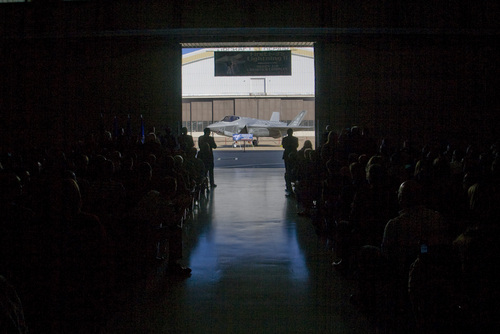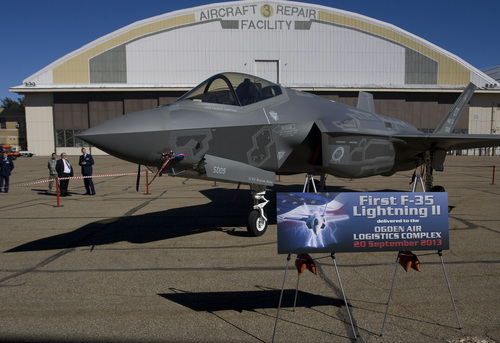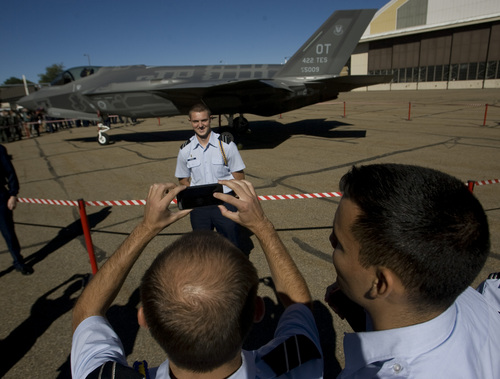This is an archived article that was published on sltrib.com in 2013, and information in the article may be outdated. It is provided only for personal research purposes and may not be reprinted.
The Pentagon on Tuesday announced Utah will be the home for the Air Force's first operational F-35A Lightning IIs, the controversial fighter jet.
The announcement was not unexpected. The U.S. Air Force said in 2010 Hill Air Force Base was a preferred site for the F-35s.
Hill will receive 72 of the jets, which will begin arriving in 2015. They will replace the 48 F-16 jets currently flown by the 388th and the 419th fighter wings.
Eighteen more F-35s will be placed at Burlington Air National Guard Station in Vermont, the Air Force also announced.
Col. Lance Landrum, the commanding officer of Hill's 388th, said the unit's mission remains the same: Provide air superiority.
"We'll just be able to do it better, more efficiently and more effectively and, most importantly, do it in a high-threat environment," Landrum said.
None of the pilots in the 388th (the active-duty fighter wing at Hill) or the 419th (the reserve unit) has flown an F-35 before. Landrum said Air Force pilots who have flown the jet in test units will join the 388th, and it's possible some F-16 pilots will be retrained.
Col. Bryan Radliff, commanding officer of the 419th, said there's a high likelihood some of its F-16 pilots will be retrained.
"We just don't know the exact numbers yet," Radliff said.
The Pentagon agreed to buy 2,500 F-35s in 2001. Since then, the F-35 is said to be the first trillion-dollar weapons project in U.S. history. That's in part because the F-35 is replacing jets used by the Air Force, the Navy and the Marine Corps. (The first operational F-35 base was Marine Corps Air Station Yuma in Arizona.) But cost overruns and project delays also have taken a toll.
That's led to debates about whether it would be a better for the United States to scrap the program in favor of continuing with F-16s and other conventional aircraft. But those conventional jets could cost more to maintain than the F-35s while being technologically inferior.
The F-35 bears Utah connections. Rep. Rob Bishop belongs to the F-35 Caucus in Congress and has been one of the project's biggest proponents.
Alliant Techsystems, of Utah, supplies components for the jet to manufacturer Lockheed Martin. Hill Air Force Base began servicing F-35s earlier this year.
Hill was also bolstered by its proximity to the Utah Test and Training Range in the state's west desert.
Landrum said the 388th has traditionally had 72 fighter jets, but an F-16 squadron was eliminated about three years ago in budget cuts. The 419th flies the same jets.
There's optimism that landing the F-35 will insulate Hill from future defense budget cuts. In 2006, former Congressman Jim Hansen, who months earlier was a commissioner in the military facility review process known as Base Realignment and Closure, told The Salt Lake Tribune the F-35 could give Hill a mission for decades to come, much like the F-16 did when it arrived at Hill in 1979.
"What it means is that Hill is going to be in pretty darn good shape," Hansen said in 2006.
Twitter: @natecarlisle —
About the F-35 Lightning II
Models are being manufactured for the Air Force, Navy and Marine Corps. Air Force models are designated as F-35A.
Reuters reported last month that South Korea, Britain, Italy, Australia, Norway, Israel and Japan also have made commitments to buy F-35s.
Each plane costs $130 million to $160 million, depending on the model, according to NPR, but that figure could drop to $85 million by 2019, Reuters also reported.
The F-35 has stealth capability and can hit surface targets as well as conduct air-to-air combat.
Sources: Respective news outlets, Tribune research







